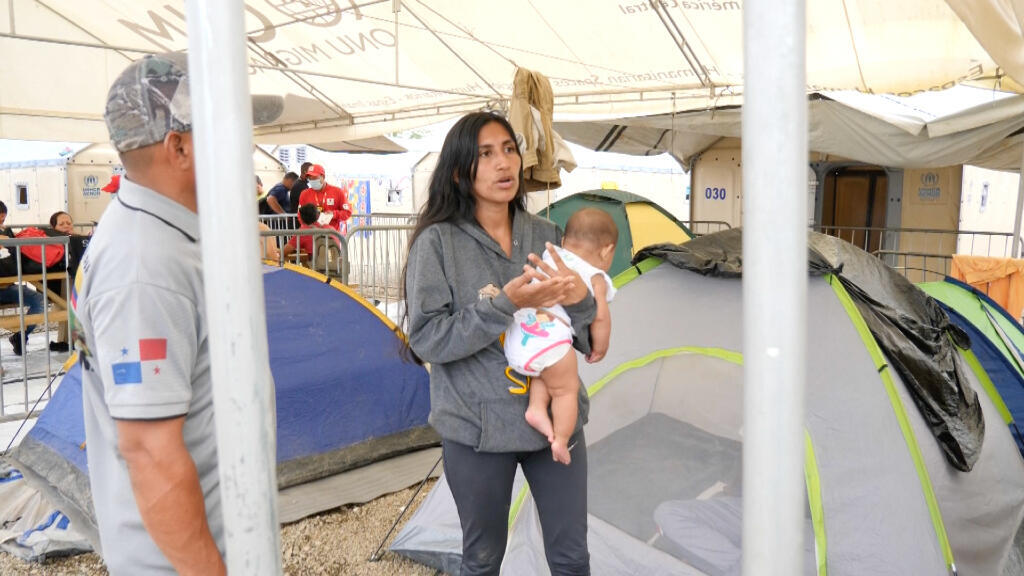To date, some 134,178 migrants have crossed the Darién Gap, a jungle that divides Colombia and Panama, considered one of the most dangerous routes in the world. The figure is higher than the 133,726 who crossed in 2021, according to official data. France 24 went to meet those who embarked on the risky journey.
walk to live In Puerto Limón, a community of pangueros in Darien, Panama, has become a small step towards hope. There, dozens of ‘pirogues’ disembark daily, transporting migrants who have just left the Darién jungle through Canaán Membrillo and find their first contact with nature.
Venezuelan Wyleiton Jimenez arrived with his wife and little one-year-old daughter. His face shows tiredness and fear as he waits for the transportation that the Panamanian authorities provide to transfer the migrants to the San Vicente Migrant Reception Center.
“Long walks, through mud, mud, dead people, animals, it really is a risk, it’s playing with the person’s life,” he says with a broken voice. “It was not easy, that responsibility as a father. I apologize to my children, what we saw in that jungle I do not wish on anyone,” she adds while holding her baby in her arms.

Jimenez was a carrier in Venezuela before crossing the jungle. He sold all of his belongings to finance the trip that was supposed to be “safe”. “There are people who cheat, they offer you packages, they tell you that in two days you will arrive and today is the ninth day and we are already here. We have no food, we ate cookies that we shared between brothers,” he explains.
According to him, the passage through the jungle, in addition to being dangerous, is more expensive than the initial budget of 2,500 dollars that he had calculated. “We have become a business for these towns, each place where you arrive, a meal costs five dollars, a water another five. The one who does not have, does not eat, I am very sorry about this, but we are a business for that jungle,” he says.
“We were able to see hundreds of people, including children and pregnant women, who needed medical attention. After walking for several days, many arrive dehydrated, with wounds, severe mosquito bites and swollen ankles. Many people are attacked by criminals, who they rob, threaten and, in dozens of cases, sexually abuse,” Juan Pappier, a researcher at Human Rights Watch, wrote in El País.
After walking 2-10 days, people arrive, often frightened and hungry, at an Indigenous community known as “El Abuelo.”
From there they take a 3-hour river boat ride to Canaán, where Panama’s immigration and border patrol agents register them. pic.twitter.com/DXdTEb76NK
— Juan Pappier (@JuanPappierHRW) May 29, 2022
“The truth is very difficult, I saw about five deaths, children, very heavy people could not get to where we were going. Those who guided us took us to a certain point, they said it was four hours and it took us two days to get there, we spent three days without eating, we drank river water. Not everyone manages to get there,” says Marco Vitora.
Vitora traveled with her brother and other friends from Venezuela. He thought that his youth and physical condition would allow him a better journey through the jungle, but it resulted in one of the most traumatic experiences of his life. “It’s very difficult, whoever wants to come has to think twice,” he concludes.

The young man had to help mothers who carried newborns in their arms. One of them is Marla Fernández, who, encouraged by her husband in the United States, entered the jungle. “The children suffer a lot. I do not wish any mother to put her children in the jungle. One enters and does not know if we are going to leave,” says Fernández in a humanitarian assistance tent in the San Vicente Center.
According to counts from the Panamanian authorities, in 2021 some 29,000 children crossed this dangerous route. Most were assisted by humanitarian organizations to leave the jungle due to injuries caused on the way.
“We have cases of unaccompanied children. Along the route through the jungle, there are many who advance, parents who stay and send their children with other people. When they arrive here at the station, we, as a responsible country, in Together with Seniaf and the childhood and adolescence unit, we receive these children and they are sent to a little house that we have until we verify where the parents are and we can hand them over to a relative,” says Víctor Gómez, of the Panama National Border Service ( Senafront).

But not only children are the most vulnerable to this journey, considered one of the most dangerous in the world. Every day there are more women who claim to be victims of sexual assault while crossing the Darién Gap.
Grizveliz Oropeza is 17 years old and this is the second time he has emigrated. She was in Ecuador as a Venezuelan migrant but her relatives insisted on coming to the United States. “An indigenous man offered me money to go to bed with him. They didn’t want to leave me from the little beach because he wanted me to go to bed with him. They really do rape women, they do rape them. I was lucky, but we feel humiliated,” Oropeza says.
“The complaints are of theft by people from the sector who take advantage of their situation, some women file complaints of rape. The service has patrols in these sectors, but the jungle is so extensive that it is not an exact place where criminals act. “, responds Gómez, from Senafront.
According to calculations by the Panamanian authorities, some 1,200 people cross the jungle daily, 70% from Venezuela. Recently the ‘coyotes’ opened new routes through the jungle and the reception centers are in trouble due to the lack of attention capacity.














